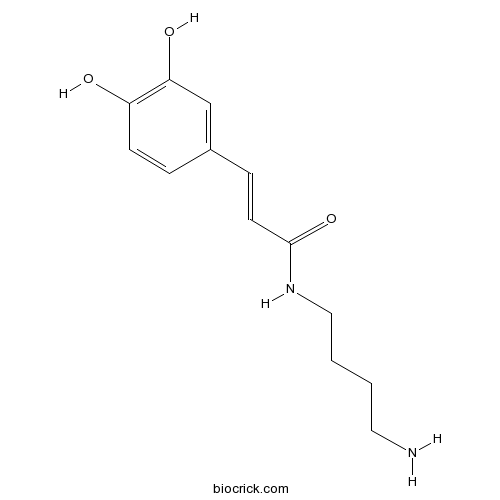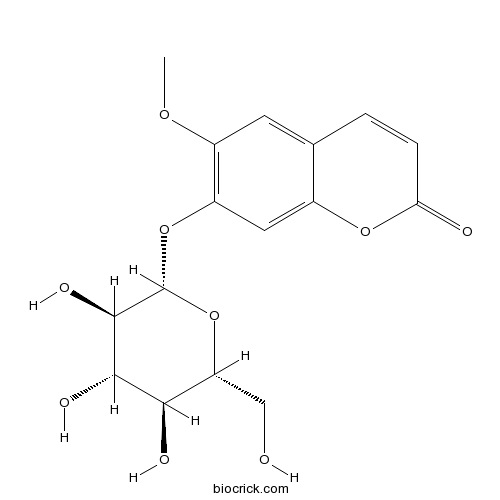Anisodus tanguticus
Anisodus tanguticus
1. The products in our compound library are selected from thousands of unique natural products; 2. It has the characteristics of diverse structure, diverse sources and wide coverage of activities; 3. Provide information on the activity of products from major journals, patents and research reports around the world, providing theoretical direction and research basis for further research and screening; 4. Free combination according to the type, source, target and disease of natural product; 5. The compound powder is placed in a covered tube and then discharged into a 10 x 10 cryostat; 6. Transport in ice pack or dry ice pack. Please store it at -20 °C as soon as possible after receiving the product, and use it as soon as possible after opening.
Natural products/compounds from Anisodus tanguticus
- Cat.No. Product Name CAS Number COA
-
BCN2920
Fabiatrin18309-73-4
Instructions

-
BCC8391
(E)-N-Caffeoylputrescine29554-26-5
Instructions

-
BCN5701
Scopolin531-44-2
Instructions

The Quaternary evolutionary history, potential distribution dynamics, and conservation implications for a Qinghai-Tibet Plateau endemic herbaceous perennial, Anisodus tanguticus (Solanaceae).[Pubmed: 27099706]
Various hypotheses have been proposed about the Quaternary evolutionary history of plant species on the Qinghai-Tibet Plateau (QTP), yet only a handful of studies have considered both population genetics and ecological niche context. In this study, we proposed and compared climate refugia hypotheses based on the phylogeographic pattern of Anisodus tanguticus (three plastid DNA fragments and nuclear internal transcribed spacer regions from 32 populations) and present and past species distribution models (SDMs). We detected six plastid haplotypes in two well-differentiated lineages. Although all haplotypes could be found in its western (sampling) area, only haplotypes from one lineage occurred in its eastern area. Meanwhile, most genetic variations existed between populations (F ST = 0.822). The SDMs during the last glacial maximum and last interglacial periods showed range fragmentation in the western area and significant range contraction in the eastern area, respectively, in comparison with current potential distribution. This species may have undergone intraspecific divergence during the early Quaternary, which may have been caused by survival in different refugia during the earliest known glacial in the QTP, rather than geological isolation due to orogenesis events. Subsequently, climate oscillations during the Quaternary resulted in a dynamic distribution range for this species as well as the distribution pattern of its plastid haplotypes and nuclear genotypes. The interglacial periods may have had a greater effect on A. tanguticus than the glacial periods. Most importantly, neither genetic data nor SDM alone can fully reveal the climate refugia history of this species. We also discuss the conservation implications for this important Tibetan folk medicine plant in light of these findings and SDMs under future climate models. Together, our results underline the necessity to combine phylogeographic and SDM approaches in future investigations of the Quaternary evolutionary history of species in topographically complex areas, such as the QTP.
[HPLC Fingerprint of Anisodus tanguticus Root].[Pubmed: 26767288]
To establish an HPLC fingerprint of Anisodus tanguticus root for its quality control.
Important poisonous plants in tibetan ethnomedicine.[Pubmed: 25594733]
Tibetan ethnomedicine is famous worldwide, both for its high effectiveness and unique cultural background. Many poisonous plants have been widely used to treat disorders in the Tibetan medicinal system. In the present review article, some representative poisonous plant species are introduced in terms of their significance in traditional Tibetan medicinal practices. They are Aconitum pendulum, Strychnos nux-vomica, Datura stramonium and Anisodus tanguticus, for which the toxic chemical constituents, bioactivities and pharmacological functions are reviewed herein. The most important toxins include aconitine, strychnine, scopolamine, and anisodamine. These toxic plants are still currently in use for pain-reduction and other purposes by Tibetan healers after processing.
[Season features of mineral elements in the root of cultivated and wild Anisodus tanguticus].[Pubmed: 20939347]
The Anisodus tanguticus (Maxim.) Pascher is a Chinese traditional medicinal material and Tibet herb of local Qing-hai. The authors collected, tanguticus and wild Anisodus tanguticus (Maxim.) Pascher, and analyzed the contents of mineral elements such as K, Ca, Fe, Na and Mg by atomic absorption spetrometer, and P by 721 spectrophotometer. The results show that: samples in different places are all rich in Mg and Na while poor in P. At the same time, Ca has a negative correlation with other elements. Compared to the others, the amount of 4 elements is higher in wild Anisodus tanguticus is higher.
Molecular characterization and expression analysis of two distinct putrescine N-methyltransferases from roots of Anisodus acutangulus.[Pubmed: 19055544]
Putrescine N-methyltransferase (PMT; EC. 2.5.1.53) catalyzes the S-adenosylmethionine-dependent N-methylation of putrescine to form N-methylputrescine, which was the first committed step in tropane alkaloid biosynthetic pathway. Two PMT cDNA clones [Anisodus acutangulus putrescine N-methyltransferase 1 (AaPMT1), GenBank Accession No. EU670745; AaPMT2, GenBank Accession No. EU670746] were obtained and characterized together from Anisodus acutangulus for the first time. The full-length cDNA of AaPMT1 was 1322 bp containing a 1014-bp open reading frame (ORF) encoding a polypeptide of 338 amino acids and AaPMT2 was 1219 bp containing a 1041-bp ORF encoding a polypeptide of 347 amino acids. Comparison of the deduced amino acid sequences of AaPMTs with those from tropane alkaloid-producing plants revealed that AaPMTs had high similarity with other plants PMT. Phylogenetic tree analysis displayed that AaPMT1 showed extensive homology with PMT from Anisodus tanguticus, and AaPMT2 had closer relationship with PMT2 from Atropa belladonna, which indicated PMTs belonged to PMT superfamily. Southern hybridization analysis of the genomic DNA revealed the occurrence of two PMT copies in A. acutangulus genome. Tissue expression pattern analysis revealed that AaPMT1 expressed strongly in roots, weakly in steams and leaves, besides, AaPMT2 presented a similar weaker trend. It indicated that AaPMTs were constitutive expression genes, which were the first reported tissue-independent PMT genes compared with other known PMT genes. AaPMT1 expression was upregulated by methyl jasmonate (MeJA) in all tissues, reaching the highest level after 24 h of the treatment. AaPMT2 also exhibited a very similar trend, whereas the expression was much weaker than that in AaPMT1. So, AaPMTs were considered to be MeJA elicitor-responsive genes and could be effectively elicited at least at the transcriptional level. The work would provide useful knowledge for tropane alkaloids biosynthesis and metabolic engineering to increase the production.
Cloning, characterization and analysis of expression profiles of a cDNA encoding a hyoscyamine 6beta-hydroxylase (H6H) from Atropa baetica Willk.[Pubmed: 18952449]
A new cDNA encoding hyoscyamine 6beta-hydroxylase (H6H, EC 1.14.11.11), a bifunctional enzyme catalyzing the last two steps in the biosynthesis of scopolamine, was isolated from Atropa baetica roots (GenBank accession no. EF442802). The full cDNA sequence showed an ORF of 1035bp, coding for a protein with 344 amino acid residues. Sequence analyses at the nucleotide level showed that this ORF shares high identity with other H6H from different plant species, such as Anisodus tanguticus and Hyoscyamus niger with 90% identity, and an almost total identity with A. belladonna (98%). Tissue expression analyses showed that the gene transcript was tissue dependent, appearing exclusively in roots, thus being the only biosynthetic site for the production of scopolamine. Furthermore, Southern hybridization experiments revealed that this gene was not part of a multigene family as appears in low copy number. Phylogenetic tree analysis indicated that A. baetica H6H had a very close relationship with A. belladonna and to a lesser extent with H. niger.
Genetic variation in the endangered Anisodus tanguticus (Solanaceae), an alpine perennial endemic to the Qinghai-Tibetan Plateau.[Pubmed: 17516136]
We used random amplified polymorphic DNA markers (RAPDs) to assess genetic variation between- and within-populations of Anisodus tanguticus (Solanaceae), an endangered perennial endemic to the Qinghai-Tibetan Plateau with important medicinal value. We recorded a total of 92 amplified bands, using 12 RAPD primers, 76 of which (P=82.61%) were polymorphic, and calculated values of H(t) and H(sp) of 0.3015 and 0.4459, respectively, suggesting a remarkably high rate of genetic variation at the species level. The average within-population diversity also appeared to be high, with P, H(e) and H(pop) values of 55.11%, 0.1948 and 0.2918, respectively. Analyses of molecular variance (AMOVA) showed that among- and between-population genetic variation accounted for 67.02% and 32.98% of the total genetic variation, respectively. In addition, Nei's coefficient of differentiation (G(ST)) was found to be high (0.35), confirming the relatively high level of genetic differentiation among the populations. These differentiation coefficients are higher than mean corresponding coefficients for outbreeding species, but lower than reported coefficients for some rare species from this region. The genetic structure of A. tanguticus has probably been shaped by its breeding attributes, biogeographic history and human impact due to collection for medicinal purposes. The observed genetic variations suggest that as many populations as possible should be considered in any planned in situ or ex situ conservation programs for this species.
[The responses of photosynthesis to strong light in the medicinal plants Anisodus tanguticus (Maxim.) Pascher and Rheum tanguticum Maxim. on the Qinghai-Tibet Plateau].[Pubmed: 16775410]
Photosynthetic electron transport and light energy allocation were studied in the alpine plants Anisodus tanguticus (Maxim.) Pascher and Rheum tanguticum Maxim. ex Balf on the Qinghai-Tibet Plateau by using gas exchange and chlorophyll fluorescence. The results indicated that apparent quantum yield (AQY) of leaves of A. tanguticus was marginally higher than that of R. tanguticum although it had a lower maximum net photosynthetic rate (Pmax). The net photosynthetic rate (P(n)) of A. tanguticus was higher than R. tanguticum within the range of middle photosynthetic photon flux density (PPFD). However, the P(n) in R. tanguticum increased concomitantly with PPFD and did not appear to show light saturation of P(n) even under 2000 micromol m(-2) s(-1) which is similar to full light in summer (Fig.1). Increasing the PPFD to 1200 micromol m(-2) s(-1) decreased the ratio of carboxylation rate to total photosynthetic electron flow rate (J(C)/J(F)) although increased the ratio of photorespiration (J(O)/J(F)) for both species. Both J(C)/J(F) and J(O)/J(F) stabilized with a PPFD of more than 1200 micromol m(-2) s(-1) (Fig.2). The changes in the ratios of Rubisco oxygenation to carboxylation (V(O)/V(C)) were similar to changes to J(O)/J(F) (Fig.3). The increase of thermal energy dissipation (D) in A. tanguticus was higher than R. tanguticum with increased PPFD (Fig.4). It can be concluded that the two species adopt different mechanisms to cope with increased solar radiation. Increasing the fractions of PSII thermal energy dissipation and electron transport through photorespiration were the main adaptations in A. tanguticus. Enhancement of photosynthetic capacity with increased PPFD to balance the higher light energy absorbed by leaves is considered the main adaptation for R. tanguticum.


